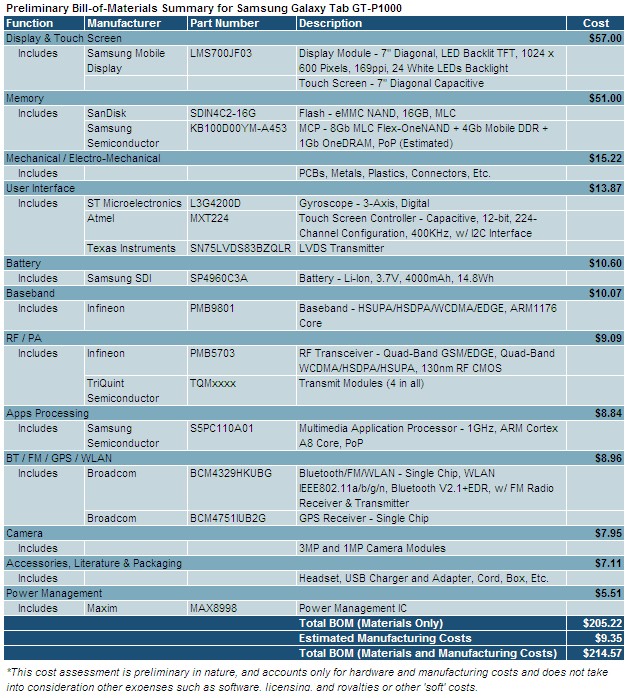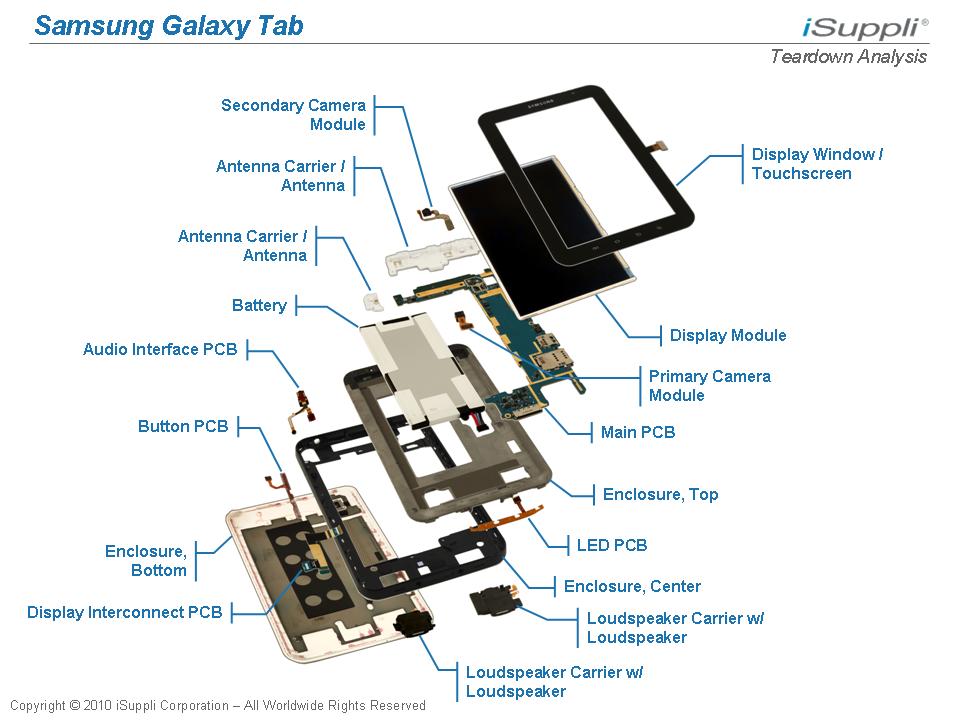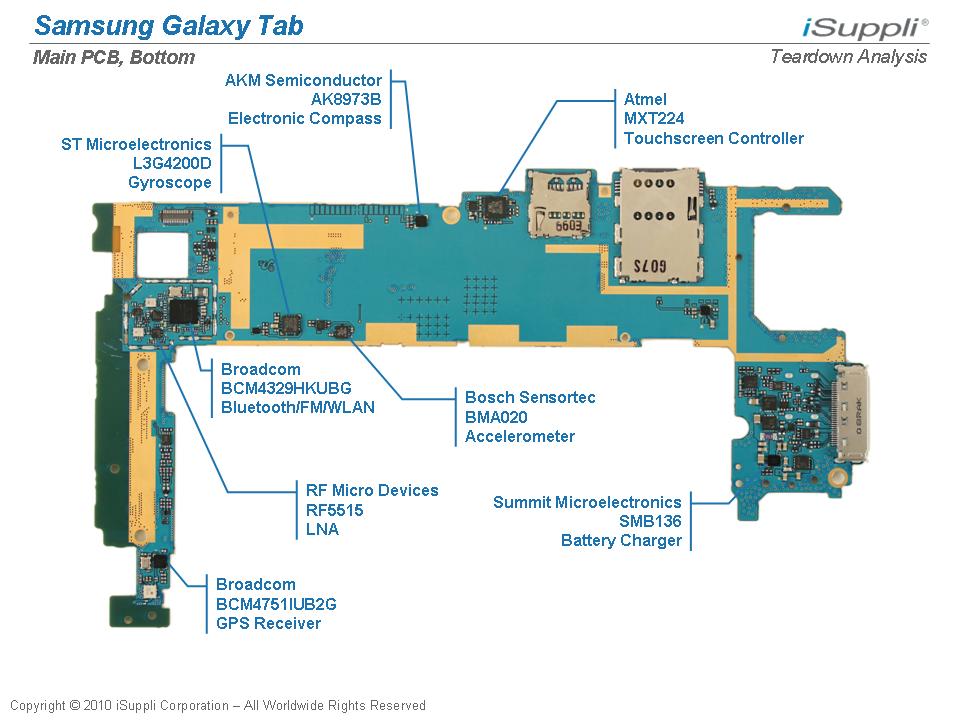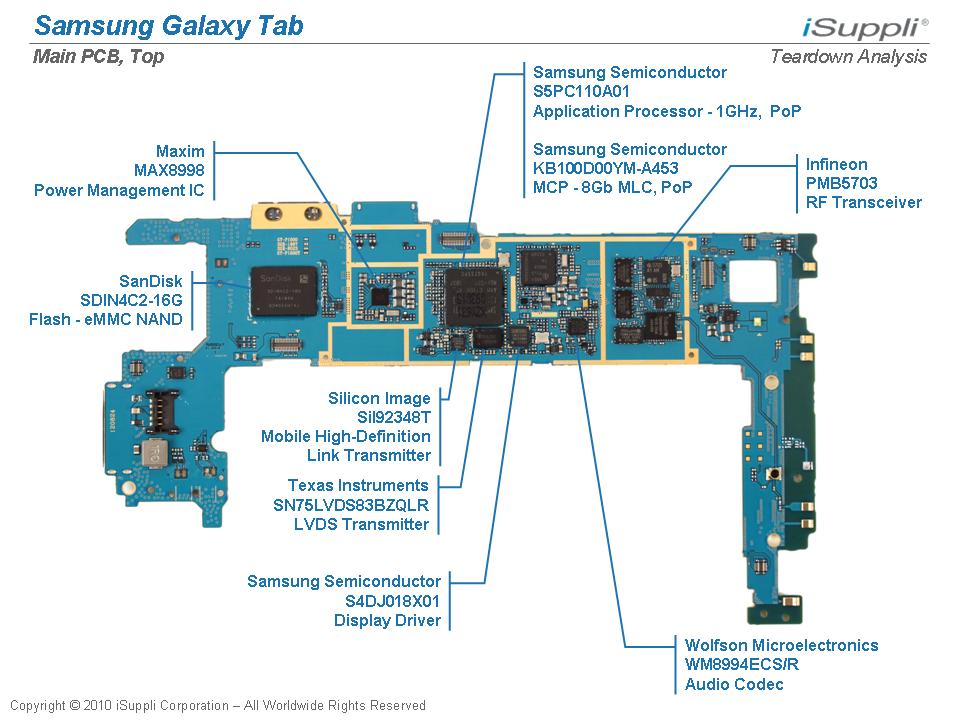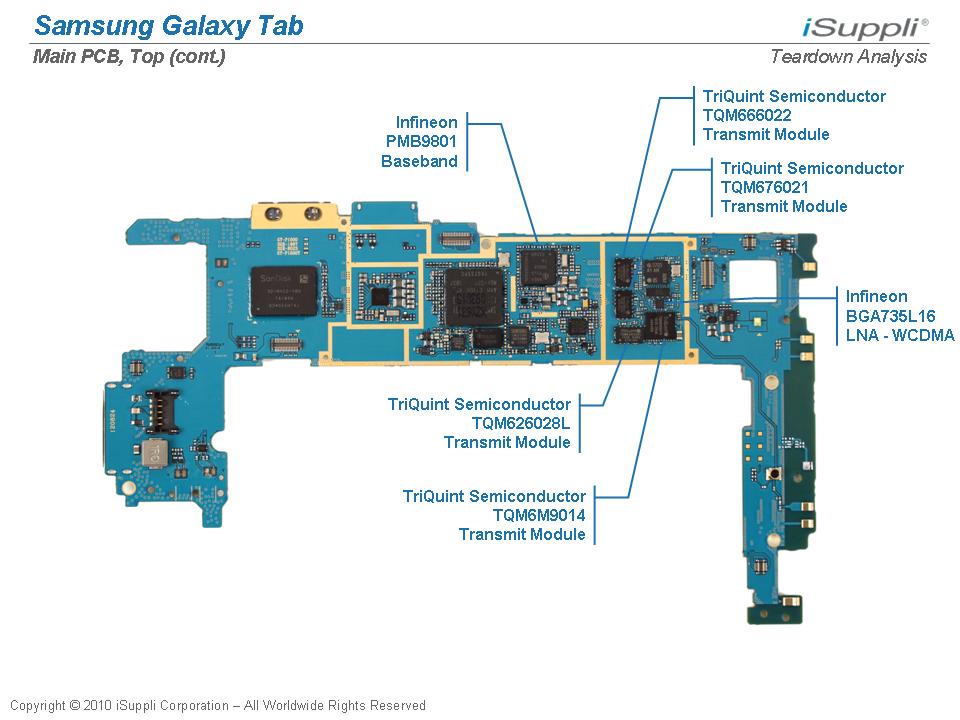 iSuppli Corp. announced that its latest analysis of the Galaxy Tab GT-P1000 suggests that Samsung has positioned it as a large-scale smart phone, rather than as a true competitor to Apple Inc.’s iPad.
iSuppli Corp. announced that its latest analysis of the Galaxy Tab GT-P1000 suggests that Samsung has positioned it as a large-scale smart phone, rather than as a true competitor to Apple Inc.’s iPad.
According to the statement, the Galaxy Tab carries a Bill of Materials (BOM) of $205.22, significantly less than iSuppli’s $264.27 estimate for the 16Gbyte 3G version of the iPad. However, the reduced cost is largely the result of the Galaxy’s smaller and lower resolution display compared to the iPad.
For more information visit: www.isuppli.com
Edited press release follows:
Samsung Galaxy Tab Carries $205 Bill of Materials, iSuppli Teardown Reveals
November 1, 2010
With its new Galaxy Tab GT-P1000, Samsung Electronics has developed a product with features and component costs that position it as a large-scale smart phone, rather than as a true competitor to Apple Inc.’s iPad, according to iSuppli Corp.
The Galaxy Tab carries a Bill of Materials (BOM) of $205.22, significantly less than iSuppli’s $264.27 estimate for the 16Gbyte 3G version of the iPad, based on the preliminary results of a dissection conducted by iSuppli’s Teardown Analysis service. However, the reduced cost is largely the result of Galaxy’s smaller and lower resolution display compared to the iPad.
“Instead of matching up with the iPad on a feature-by-feature basis, the Galaxy Tab really is larger version of Samsung’s Galaxy S smart phone,” said Andrew Rassweiler, director, principal analyst and teardown services manager for iSuppli. “While the design approach makes the Galaxy less expensive to produce than the iPad 3G, it also makes for a product that lacks the same usability. The Galaxy Tab’s screen resolution, size and technology are not at the same level as the iPad. This is a critical difference, given the fact that the display is a key differentiating factor for the iPad.”
On the plus side for the Galaxy Tab, the device includes some features not found in the iPad. For example, the Galaxy Tab includes a gyroscopic Microelectromechanical Systems (MEMS) sensor, likely for use in gaming. Furthermore, the Galaxy Tab comes with a primary 3 Megapixel (MP) autofocus camera along with a 1.3MP front-facing or video conferencing camera. Finally, the Galaxy Tab includes build-in support for Adobe’s Flash to provide more universal Web browsing—something notably lacking from the iPad.
When the $9.35 manufacturing cost of the Galaxy Tab is added in, the combined materials and production cost amounts to $214.57.
The Expanding Galaxy
Aside from the use of a larger display, the component content of the Galaxy Tab closely resembles that of the Samsung Galaxy S smart phone. Notably, both feature a Samsung-branded Hummingbird 1GHz ARM-based applications processor and an Infineon Technologies baseband processor that controls the wireless telephony/communication portion of the design.
The Galaxy Tab is a functional cell phone as well as tablet computing device, running 3G (UMTS/HSPA) in three frequency bands. According to Samsung, Galaxy Tab users can download applications from the Samsung Apps store and digital media from the company’s Hub service.
Display of Thrift
The Galaxy Tab employs a 7-inch TFT-LCD display with a 1,024 by 600 resolution. In contrast, the iPad uses a larger 9.7-inch diagonal display with a resolution of 1,024 by 768 pixels. While also using a TFT-LCD display, the iPad adds In-Plane Switching (IPS) technology, which enhances the viewing angle and picture quality.
iSuppli estimates the cost of the display/touch subsystem in the Galaxy Tab at $57; The comparable figure in the iPad analysis would be $98. As in most new smart phone and tablet designs dissected by iSuppli’s Teardown Analysis service, the display and touch screen represent the most expensive portion of the design, accounting for 27.8 percent of the Galaxy Tab’s total BOM. Samsung Mobile Display is the source of the LCD screen.
Stardust Memories
Next on the cost ranking is the memory subsystem, at a cost of $51, representing 24.9 percent of the total BOM.
This subsystem features a 16Gbyte of Multilevel Cell (MLC) NAND flash memory from SanDisk Corp. It also includes a Samsung multichip package combining 8Gbits of MLC Flex-OneNAND, 4Gbits of mobile Double Data Rate (DDR) mobile DRAM and 1Gbit of OneDRAM.
The numerous mechanical and electromechanical components represent the third most expensive electronic subsystem in the Galaxy Tab, at a cost of $15.22, or 7.4 percent of the BOM.
User Interface Facts
The user interface subsystem is fourth on the cost list at $13.87, or 6.8 percent of the BOM. This section includes the gyroscope—a 3-axis device from STMicroelectronics. It also features a capacitive touch screen controller from Atmel Corp. and an LVDS transmitter from Texas Instruments Inc.
Next on the cost countdown is the Samsung-supplied battery, at $10.60, or 5.2 percent of the BOM.
No. 6 on the cost list is the baseband subsystem, featuring an integrated circuit from Infineon, at a cost of $10.07, accounting for 4.9 percent of the BOM.
Radio Frequency and More
Coming in seventh on the cost list is the radio frequency/power amplifier subsystem at $9.09, or 4.4 percent of the BOM. This system features an Infineon radio frequency transceiver and four TriQuint Semiconductor transmit modules.
Next is the applications processing subsystem at $8.84, or 4.3 percent of the BOM. This section includes the previously mentioned apps processor from Samsung.
Other notable suppliers include a single-chip Bluetooth/FM/WLAN controller and a GPS receiver device from Broadcom Corp. Maxim Integrated Products contributed a power management Integrated Circuit (IC).
Samsung Galaxy Tab Teardown Photo Analysis
The following represents a sample of the photographs of the Samsung Galaxy Tab teardown analysis. These images are annotated to include suppliers and functional areas.
